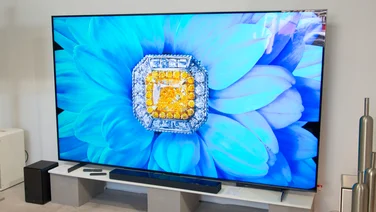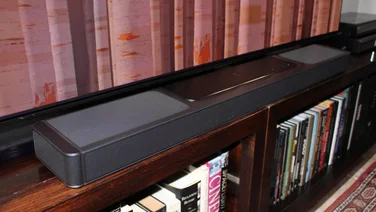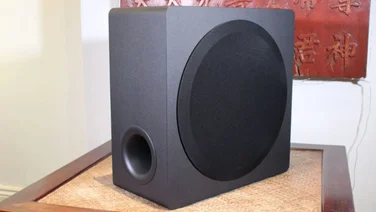To help us provide you with free impartial advice, we may earn a commission if you buy through links on our site. Learn more






The TX-L47ET60B, Panasonic’s first 3D LCD TV for 2013, is a feature-packed TV with a brand new user interface, full smart TV integration and passive 3D support, as well as many image quality settings and controls usually found in much higher-end TVs.

The new online services interface greets you as soon as you turn on the TV. The Home screen, which can be customised with an array of shortcuts, bookmarks, live previews, widgets and TV listings, lets you access frequently used features or watch broadcast TV straight away. The live feed from the currently selected source consumes most of the screen, so you don’t have to miss out on the action just to check what’s coming up next. You can even stick a shared family calendar or shopping list on the Home page.
One Home screen is dedicated to smart TV content, of which there’s a reasonable amount. Netflix, BBC iPlayer and YouTube are all present, as is Panasonic’s own app store, where you can download additional apps. Some are free, but you’ll have to pay for others. It also has Facebook and Twitter, along with Skype for video calling, assuming you have the optional Panasonic TY-CC20W Skype camera (£90 from www.currys.co.uk). There aren’t quite as many services as on a 2013 Samsung or Sony TV, but it’s still one of the best collections of smart TV apps, especially as you can stick your most frequently used apps on the home screen for easy access.

If you prefer to watch your own videos rather than stream them from the internet, you can use one of the two USB ports at the back of the set to play media from a flash drive. The TX-L47ET60B has reasonable file format support. We could play all our audio and image test files, and most of our videos, but the TV refused to recognise our native DivX and MOV files. Although the media player interface hasn’t received the same design attention as the Home screen UI, the live preview thumbnails are a nice touch. The second USB port comes in handy if you have a spare external hard disk, as you can use it to turn the TV into a rudimentary PVR.
All inputs are located on the back of the set, where you’ll find three HDMI inputs. This is slightly disappointing when you consider that many TVs now have four or five HDMI inputs. It also has a component video input, composite and SCART video inputs (via an adaptor), digital optical audio and an aerial connection. There’s also an SD card input, which could prove useful for photographers and videographers. The TX-L47ET60B has integrated Wi-Fi as well as an Ethernet port to connect the TV to a network.

Unsurprisingly, sound quality isn’t the TX-L47ET60B’s strong point. The slim body doesn’t lend itself to large speaker drivers, hence the pair of tinny 4W drivers installed in TX-L47ET60B. It lacks bass, despite the presence of a small 10w subwoofer.
The ET60B fares much better in terms of picture quality, although it’s much more of a mixed bag than Panasonic’s plasma models. Unlike the entry-level Panasonic TX-L32E6B, which uses MVA technology for its display, the TX-L47ET60B uses an IPS panel. This means support for 3D and excellent viewing angles, but it also means slightly inferior black levels. It has slightly greyer blacks than we’d like, and mediocre contrast.
Panasonic’s True Cinema picture mode is fantastic, so it should come as no surprise that we used it to test Full HD Blu-ray content. The more in-depth colour management system is available for anyone who likes to tweak things further, but it copes impeccably out of the box with accurate colours and plenty of detail. We did spot a little bit of light leaking from the bottom corner, and its shadow detail could be better, but it’s on par with similarly priced TVs from other manufacturers.
The TX-L47ET60B’s 100Hz panel copes well during fast moving scenes, with minimal judder, although there’s still some noticeable blur during very rapid motion. Enabling Intelligent Frame Creation (IFC) can help smooth these scenes for standard definition and broadcast footage, but is best left off for Blu-ray because it produces an unrealistic sheen and small tears around moving objects.
The TX-L47ET60B uses passive 3D. This means no light flicker, much less crosstalk (there was a small amount visible during testing) and only a slight drop in brightness. However, horizontal lines are noticeable if you sit too close to the set and fast-moving objects suffered from similar artefacts to those seen with Intelligent Frame Creation enabled. It’s a shame Panasonic only bundles two pairs of 3D glasses with the TX-L47ET60B, as many other manufacturers provide four pairs of passive 3D glasses.

The L47ET60B isn’t cheap, and although its smart TV system is a major improvement over last year’s models and the number of extra features is impressive, passive 3D doesn’t give it the edge over the less expensive E6B model. It’s still a very competent TV, but we recommend buying Panasonic E6B-series TV instead, such as the Budget Buy-winning Panasonic Smart Viera LED TV TX-L32E6B.






